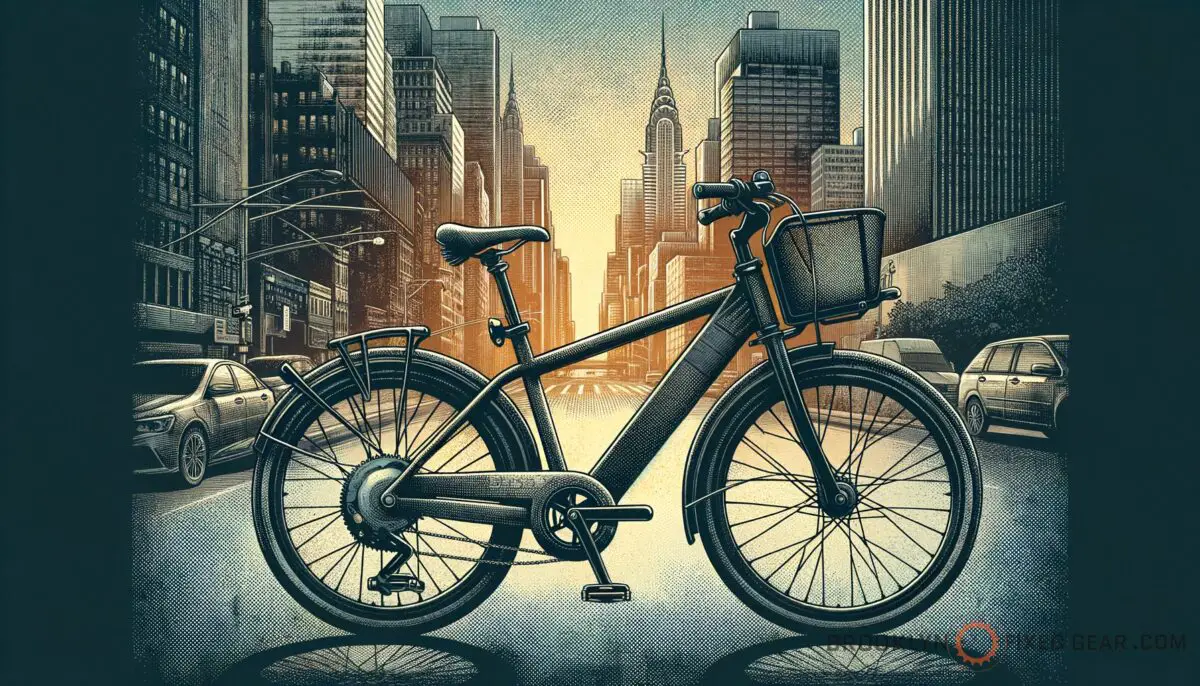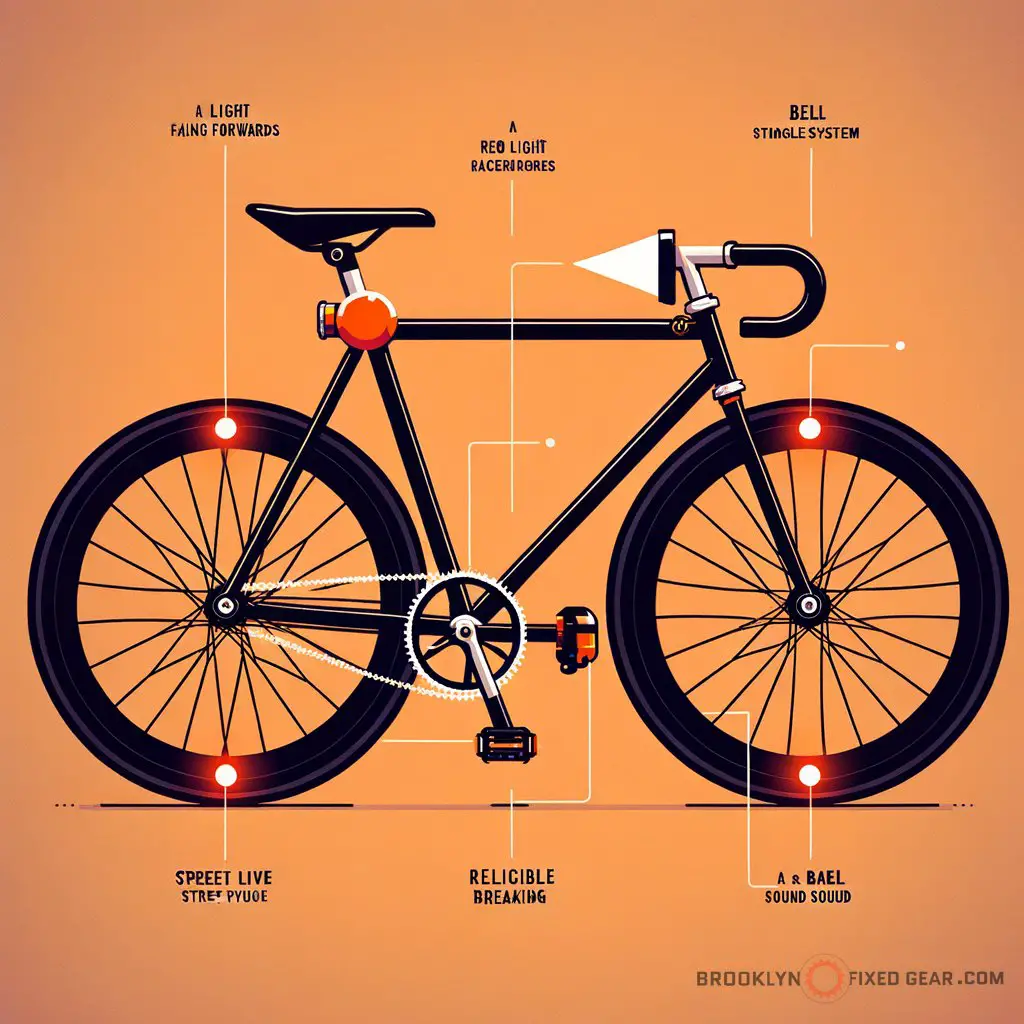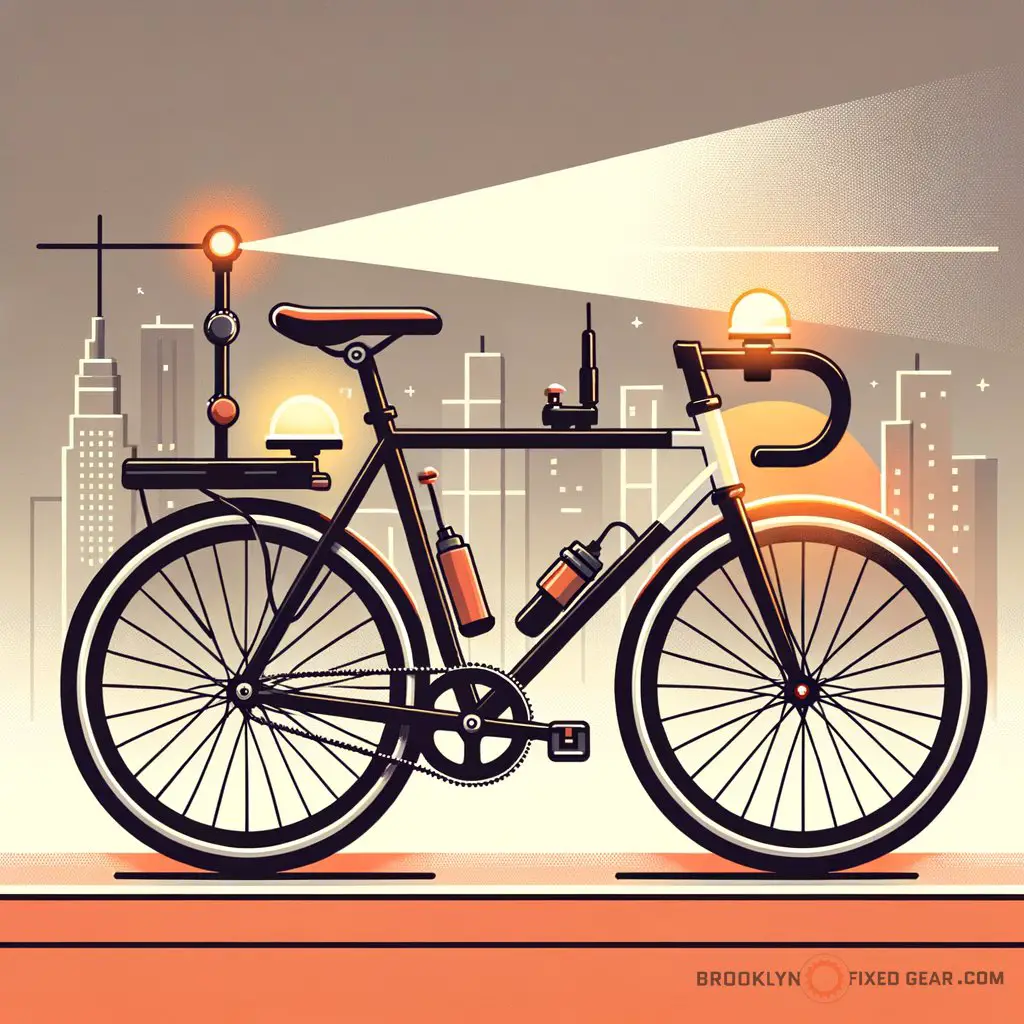Ever scoped out the best fixie bikes and wondered if they’re up to snuff for city riding? You’ll learn about the essentials that transform any two-wheeler into street-legal transportation, whether you’re coasting on a fixie or sprinting on a track bike.
Key takeaways
- Equip with lights and reflectors to ensure you’re visible at night.
- Audible signals like bells or horns are mandatory for safe riding.
- Keep brakes in check for control in unpredictable street scenarios.
What makes a bike street safe or legal
Staying legal on the streets isn’t just about obeying traffic signals and rules; your bike must meet certain safety requirements. Let’s pedal into what flags a bike as street-ready.

First off, visibility is key. A bike should have reflective gear and lights, especially for those twilight rides through Brooklyn. You’re required to have a white light pointing forward and a red light at the back.
This isn’t up for debate; it’s the law.
Then, there’s the matter of audible signals. A bell or a horn that can be heard from at least 100 feet away warns pedestrians and fellow riders you’re whizzing by. No subtle ding will cut it.
Lastly, brakes – a fixed-gear bike relies on pedal resistance to stop, but you still need a functioning brake. It’s all about control, especially when it’s a mad rush during rush hour.
- Don’t forget:
- Reflective materials & lights for visibility
- Audible signal devices like bells or horns
- Reliable braking system
You’ll find the right gear that won’t break the bank and keeps you street-legal with a visit to the selection of bike bells and horns.
Opinion time – and keep in mind, it’s just what I think, not the word of a track bike deity or anything. Street safety on a bike is a bit like a dance you didn’t know you’d signed up for. Sometimes it feels like all eyes are on you, trying to guess your next move.
I remember this scene from ‘Premium Rush’, where Joseph Gordon-Levitt’s character threads through Manhattan traffic with just his wit and fixed-gear bike – a testament to the importance of skill, but you still need your bike to be legally sound.
Reflectors and lights aren’t just add-ons; they’re your bike’s lifeline after dark. Stick a white light on the front and a red one on the back becausebeing seen is as vital as nailing that perfect pedal stroke.
I reckon sometimes regulations feel like a drag, especially when you’re customizing your fixie. Those moments when I’m picking out the perfect saddle or handlebars for my ride, I don’t want to think about whether they meet legal standards. But at the end of the day, those rules aren’t just some arbitrary checklist – they’re the difference between a smooth ride and a potential run-in with Murphy’s law, or worse, an actual cop.
Remember, safety is cool, cuffs aren’t – unless they’re on your skinny jeans.
State Bicycle Co. Black Label 6061

State Bicycle Co. Black Label 6061
Safety requirements for legal street riding
When it comes to keeping your ride street legal, safety is the front wheel. You don’t want to get in a tangle with the law or, worse, find yourself in an unsafe situation.
Reflective gear and lights
Cyclists must have a way to be seen when the sunlight drops. A white light at the front and a red rear light are as mandatory as a chain on a fixie. It’s like your bike’s fashion statement with a safety twist.

Also, slap on some reflective stickers or tape for that extra glow.
Reflectors and lights are crucial for visibility during those nocturnal jaunts. Without them, you’re like a ghost in the night – and not the cool kind. Bolster your setup with the best fixie bike lights to ensure you aren’t missed.
Bells and horns
Your voice might be loud, but it won’t cut it legally. An audible warning device, like a bell or horn, lets everyone know you’re sharing the pavement. It needs to carry at least 100 feet, so when you chime or honk, you’re heard, not just ignored.
Clear signals save lives, literally. If your bell’s sound doesn’t travel far enough, it’s no good. Check out some quality audible signal devices that offer right range and clarity.
Braking systems
Brakes – who needs ’em? You do! Even if you’re the king of skidding on your fixie, a physical brake that can handle a sudden halt is non-negotiable.
A reliable braking system is your best friend when that yellow cab decides to cut in. It’s not just about stopping power; it’s about control. You can find some solid options for keeping it legal while maintaining your ride’s aesthetics with essential bike maintenance tools.
More legal requirements for bikes
While the big three above will keep you in the clear mostly, there’s more to legal biking than lights, bells, and brakes.
Bike lane usage
If there’s a bike lane, you’re expected to use it. Swerving into traffic because you prefer the open road can get you a ticket – or worse.
Stick to the bike lanes when they’re available, and always signal your intentions to drivers and other cyclists. You want to flow with the traffic, not against it.
Helmet laws
In some places, your noggin needs protection. Sure, it might not be required everywhere for adults, but always check your local laws.
Wearing a helmet could be the difference between a close call and a catastrophe. Plus, there are plenty of stylish options that won’t cramp your street cred.
For the specifics on your local laws and some sick helmet recommendations, head over to local cycling safety regulations.
Street etiquette and other considerations
Finally, let’s tap into the less legal but just as important elements that contribute to a safe and pleasant ride.
Courtesy to pedestrians
Sharing the road goes both ways. Yield to pedestrians, and don’t zip through crosswalks when people are walking.
Being respectful can prevent accidents and keeps the peace between cyclists and walkers. It’s the unwritten rule of the road.
Listening to music safely
Music fuels our rides, but blasting tunes through headphones can make you unaware of your environment. Keep one ear open or stick to a bike-mounted speaker.
Stay alert while enjoying your beats to ensure you catch those crucial audio cues from the world around you. It makes all the difference in reaction time.
Parking your bike
Don’t be that person who locks their bike to someone’s front gate. Use bike racks or designated areas to keep sidewalks clear and avoid fines or bad karma.
Proper parking is part of being a considerate cyclist, and it can keep your bike from getting impounded or damaged.
Here’s a breakdown of the essential legal kit for your bike:
| Legal Requirement | Description | Importance |
|---|---|---|
| Front white light | Must be visible from a distance | Critical |
| Rear red light | Alerts traffic from behind | Critical |
| Reflectors | Enhance visibility with car lights | Critical |
| Horn or Bell | Audio device audible for 100 feet | Critical |
| Brakes | Must have a physical brake system | Critical |
| Helmet | Depends on local laws | Varies |
| Bike Lane Usage | Follow lane designations | Legal |
Navigating the streets on your beloved set of wheels calls for more than just pumping the pedals. Aside from the must-have legal fixtures, there’s a rhythm to riding right – a harmony of do’s and don’ts that’ll keep you spinning safely and sagely. Here’s the down-low on cycling etiquette that paves the road to a better bike life.
| Do | Don’t |
|---|---|
| Equip your bike with lights | Ride without a functioning brake |
| Use a bell or horn to signal | Ignore traffic signals and signs |
| Wear a helmet in required areas | Weave in and out of traffic erratically |
| Follow bike lane rules | Distract yourself with electronics |
| Conduct regular bike maintenance | Chain your bike to unauthorized areas |

More cycling safety tips
Dialing in your street smarts isn’t just about avoiding tickets; it’s about crafting a smooth, enjoyable cycling experience. When you take to the streets, these nifty nuggets of know-how can be as clutch as finding that perfect gear ratio on your fixie.
Here are more tweaks and tricks to level up your legal and safe cycling game:
- Plan your route before you ride to stick to bike-friendly roads and avoid last-minute detours.
- Stay visible at all times by wearing bright clothing or adding more reflective gear to your bike.
- Communicate clearly with hand signals, making sure you’re predictable to others on the road.
- Keep your bike in tip-top shape with regular tune-ups and inspections. Knowing how to choose a bike saddle that won’t wreak havoc on your ride is a skill on its own.
- Don’t get distracted; keep your focus on the road ahead, even if you’re cruising on familiar turf.
- Understand and be aware of your local laws to ensure you’re always in the clear.
- Be patient, especially in heavy traffic. It’s better to lose a minute than to take unnecessary risks.
- Ride with confidence and claim your space on the road, but always be courteous and share the road graciously.
If you are a visual learner, check out this video titled ‘Living with a street bike VS dirt bike (Pros & Cons)’
Frequently asked questions (FAQ)
Do I need a license to ride a bike on the street?
No, you don’t need a license to ride a bicycle on the street, but you’re expected to know and follow the same traffic laws that apply to motorists. Riding without this knowledge increases the risk of accidents and legal issues.
Can I modify my bike and still keep it street legal?
Yes, you can customize your bike, but any modifications must not compromise essential safety features such as brakes, lights, and reflectors. Always prioritize safety and legality over aesthetics. It’s also wise to understand the common mistakes made when building a fixie.
Is it mandatory to have insurance for my bicycle?
Bike insurance isn’t mandatory like it is for motor vehicles, but it is recommended, especially if you rely on your bike for daily commuting or have invested significantly in a high-end model. Insurance can protect against theft and damages that could occur on the street.
Final thoughts
As we roll to a stop, remember that keeping your bike street safe and legal is a mix of common sense and compliance. Lights, reflectors, and a hearty bell or horn are your ticket to a stress-free ride—whether making a dash across town or enjoying a leisurely evening pedal. Safety gear may not earn you style points, but it’ll keep you in the clear and out of harm’s way.
Do you feel equipped with the knowledge to make your bike a shining example of urban roadworthiness? I read and reply to every comment. If you found this article helpful, share it with a friend, and check out my full blog for more tips and tricks on cycling safety and street legality. Thanks for reading, and stay rubber side down!















